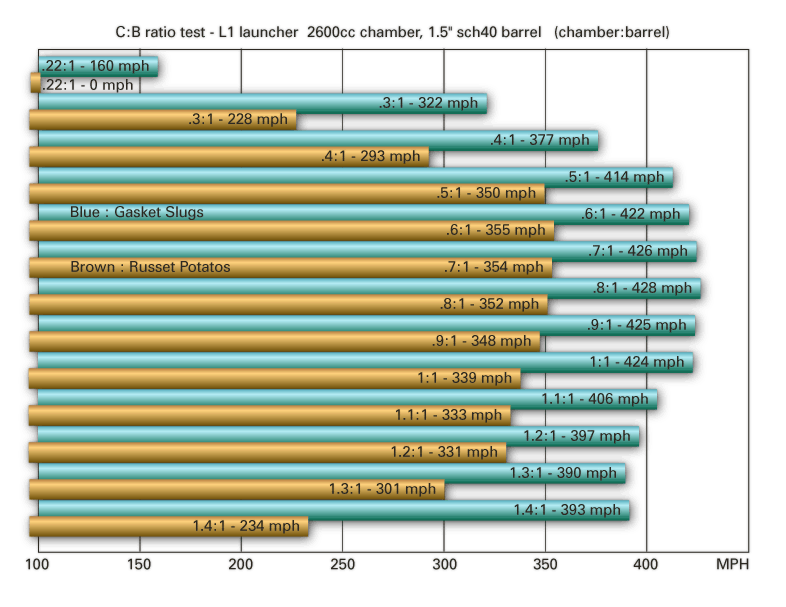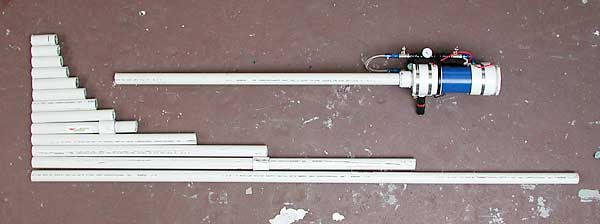How can these ratios be right?
-
djwilliams0822
- Recruit

- Posts: 2
- Joined: Fri May 04, 2012 11:59 am
I am wondering why do you think a 1.5:1 ratio will make more power than say a 4:1? I have a 4:1 and it has a lot of power. My thinking is the more gas that is expanding will create more power. If you think of it in a way or cars. The bigger the cylinder the more power it has, so why not have a big chamber and a smaller barrel? My chamber is 4x24 my barrel is 2x24 it is louder but that isn't an issue. Can someone please explain?[/img]
- velocity3x
- Corporal 4

- Posts: 828
- Joined: Fri Jun 05, 2009 3:09 pm
- Location: Yuma, Arizona
- Contact:
The 4:1 ratio will make more power, but it's a diminishing return. With 4:1 ratio, there's a good chance that the projectile has cleared the muzzle before all the gas has fully expanded.djwilliams0822 wrote:I am wondering why do you think a 1.5:1 ratio will make more power than say a 4:1? I have a 4:1 and it has a lot of power.
-
djwilliams0822
- Recruit

- Posts: 2
- Joined: Fri May 04, 2012 11:59 am
Right it will. But the pressure will build faster so it wont leave at the peak of its power but it should leave at more speed than the smaller.
- jackssmirkingrevenge
- Five Star General

- Posts: 26216
- Joined: Thu Mar 15, 2007 11:28 pm
- Has thanked: 576 times
- Been thanked: 347 times
The data where such assumptions come from is mostly here:
http://www.burntlatke.com/launch.html

This was done for a fixed chamber volume but altering barrel length:

http://www.burntlatke.com/launch.html

This was done for a fixed chamber volume but altering barrel length:

hectmarr wrote:You have to make many weapons, because this field is long and short life
- jimmy101
- Sergeant Major 2


- Posts: 3209
- Joined: Wed Mar 28, 2007 9:48 am
- Location: Greenwood, Indiana
- Has thanked: 6 times
- Been thanked: 18 times
- Contact:
Partly what velocity3x (and Jack's post answers a different question, it doesn't address, for example, taking Latke's optimal 0.8 barrel and putting a bigger chamber on it).
In going from a 1.5 to 4 CB ratio you will have more energy available but that more than doubling of the chamber's volume won't do much more than increase the ammo's velocity by a few tens of FPS. So is it really worth it?
Another issue is burn speed. The bigger the chamber the longer it takes to burn. With a sufficiently large chamber the ammo will have exited the barrel before the fuel has been fully burned. That means the ammo was moving down the barrel being pushed by less pressure than if the chamber had been smaller and had burned completely. In the extreme case of a really huge chamber the entire acceleration of the ammo will be at whatever pressure is needed to overcome static friction. For a really tight fitting spud in a 2" barrel that pressure would only be in the range of ten or so PSIG. The burn takes too long and the ammo is long gone before much pressure builds.
In going from a 1.5 to 4 CB ratio you will have more energy available but that more than doubling of the chamber's volume won't do much more than increase the ammo's velocity by a few tens of FPS. So is it really worth it?
Another issue is burn speed. The bigger the chamber the longer it takes to burn. With a sufficiently large chamber the ammo will have exited the barrel before the fuel has been fully burned. That means the ammo was moving down the barrel being pushed by less pressure than if the chamber had been smaller and had burned completely. In the extreme case of a really huge chamber the entire acceleration of the ammo will be at whatever pressure is needed to overcome static friction. For a really tight fitting spud in a 2" barrel that pressure would only be in the range of ten or so PSIG. The burn takes too long and the ammo is long gone before much pressure builds.

Jimmy covered essentially all the relevant points.
It also needs to be ascertained whether the poster is looking at optimal CB for a given barrel, or a given chamber. For a given chamber, increasing barrel length will increase performance until the projectile base pressure is equal to the pressure in front of the projectile (in a low pressure combustion gun, this will be approximately atmospheric pressure).
For a given barrel, increasing chamber size will increase performance so long as the effect is to increase the average effective projectile base pressure (AEPBP). Eventually performance will begin to decrease due to fuel burn rate limitations for excessively large chambers.
What may surprise you is that, even for a fuel which burns instantly regardless of chamber volume, as chamber size is increased the AEPBP will approach a limiting value which is NOT the initial chamber pressure, unless the propellant is also massless.
The bottom line is that a "sweet spot" exists whether your limitation is the barrel or the chamber. 0.8:1 is, as mentioned above, roughly the location of that sweet spot when one is dealing with a fixed chamber volume.
It also needs to be ascertained whether the poster is looking at optimal CB for a given barrel, or a given chamber. For a given chamber, increasing barrel length will increase performance until the projectile base pressure is equal to the pressure in front of the projectile (in a low pressure combustion gun, this will be approximately atmospheric pressure).
For a given barrel, increasing chamber size will increase performance so long as the effect is to increase the average effective projectile base pressure (AEPBP). Eventually performance will begin to decrease due to fuel burn rate limitations for excessively large chambers.
What may surprise you is that, even for a fuel which burns instantly regardless of chamber volume, as chamber size is increased the AEPBP will approach a limiting value which is NOT the initial chamber pressure, unless the propellant is also massless.
The bottom line is that a "sweet spot" exists whether your limitation is the barrel or the chamber. 0.8:1 is, as mentioned above, roughly the location of that sweet spot when one is dealing with a fixed chamber volume.
Spudfiles' resident expert on all things that sail through the air at improbable speeds, trailing an incandescent wake of ionized air, dissociated polymers and metal oxides.


